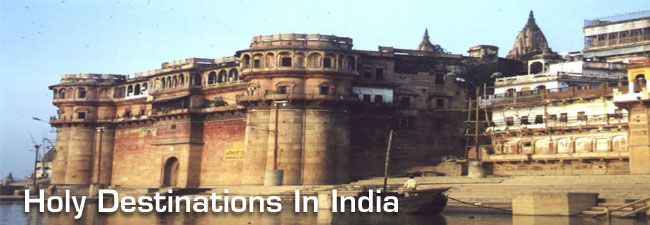 Shirdi
Shirdi
One of the foremost saints of modern India, lived in the small
village of Shirdi in the state of Maharashtra for sixty years.
Due to his presence there even after his Samadhi, today the
small village has transformed itself as a great spiritual centre
to people from all religions. Shri Sai Baba, in spite of his
great spiritual stature, never publicized himself through discoursing,
touring and preaching---unlike many of today's 'so-called' saints.
Rather, he discouraged unnecessary publicity. But still, his
spiritual perfection is still drawing innumerable devotees to
him from all over the world.
Sai Baba did never reveal his original name, time and place
of birth, especially his religion and caste, and even the names
of his parents. Through this, he has emerged as a solution to
all the religious and communal differences that are destroying
the world today. He preaches that God is Almighty and he has
given all the souls on earth equal opportunity to reach him,
whichever is the religion they belong to. 'Sai Baba' is the
name given to him by his first devotee, Mahalsapathi - 'Sai'
means 'Saint' and 'Baba' means 'Father'. The name is just an
expression of love, reverence and devotion.
Location
Shirdi town is situated in Ahmednagar District of Maharashtra
State. It falls on Ahmednagar-Manmad State Highway No.10 at
83 Km. from Ahmednagar, and 15 Km. from Kopargaon.
Pilgrim Attractions
Samadhi Mandir:
Samadhi Mandir of Shri Sai Baba was actually owned by a millionaire
from Nagpur, a famous Sai devotee Shreemant Gopalrao. Gopalrao
wanted to keep an idol of Murlidhar here. However, Baba himself
became Murlidhar and the Mandir became the Samadhi Mandir of
Baba.
The Mandir is built with stones and Baba's Samadhi is built
with white marble stones. A railing is built in marble around
the Samadhi and is full of ornamental decorations. In front
of the Samadhi are two silver pillars full of decorative designs.
Just behind the Samadhi is Sai Baba's marvelous statue made
of Italian marble, which shows him seated on a throne. Late
Balaji Vasant made this idol.
Dwarkamai
Shri Sai Baba came to Shridhi with a marriage procession.
He stayed at Dwarkamai till the very end of his life. Dwarkamai
is situated on the right side of the entrance of Samadhi Mandir.
Here he solved problems of the people, cured their sickness
and worries. Before Baba's arrival in Shridhi, Dwarkamai was
an old mosque in a dilapidated condition. Baba turned it into
Dwarkamai and proved that God is one.
The first level of Dwarkamai has a portrait of Baba and a big
stone on which Baba used to sit. This level has two rooms. One
contains the chariot and the second a palkhi. Just in front
of the room where the chariot is kept is a small temple. A saffron
flag flies over it.
The second level of Dwarkamai has a square stool made of stone,
which Baba used for taking a bath. The main attraction of this
place is the oil painting of Shri Sai Baba sitting in a carved
wooden shrine. This level also has the grinding stone and the
wooden vessel called Kolamba in which Baba used to keep the
Bhiksha brought from the village.
Gurusthan
Sai Baba first came to Shridhi in the form of Bal Yogi - a
child ascetic. He was first spotted seated under a Neem tree.
This place came to be known as Gurusthan. The renovation of
Gurusthan was made on 30th September 1941. The present temple
was built after this period. There is a small shrine in Gurusthan.
On a elevated platform of this shrine a big portrait of Baba
is placed. On the side is a marble statue of Baba. In front
of the portrait are a Shivling and the Nandi. Photos of twelve
Jyotirlingas are kept in the temple. The branches of the Neem
tree have come out through the roof of the temple.
At a short distance lies Baba's CHAVADI. Baba used to sleep
here every alternate day. The Chavadi is divided into two parts.
One part of the Chavadi has a large portrait of Baba along with
a wooden bed and a white chair belonging to him.There is a cottage
of Abdul Baba, an ardent devotee of Shri Sai Baba, in front
of the Chavadi. Abdul Baba looked after the Lendi Baug. There
are photos and various things, which were handled by Sai Baba
and Abdul Baba in the cottage.
Lendi Baug
At some distance from Gurusthan there is the Lendi Baug. This
Baug was made and watered daily by Baba himself. It got its
name from a Nalla (a drain), which used to previously flow there.
Baba used to come here every morning and afternoon and take
rest under a Neem tree. Baba dug a pit, 2 feet deep, under the
Neem tree and kept a Deep lit in that pit. One octangular Deepgriha
called Nanda Deep has been built in marble stone in memory of
this place. It constantly burns in a glass box. On one side
of the Deepgriha is a Peepal tree and on the other side is a
Neem tree.
Some distance away is a Datta Mandir below an Audumbar tree.
In the Mandir there is a statue of Datta built in marble stone.
The statue of Datta was installed on 6th December 1976. Just
behind the Datta Mandir is a Samadhi of the horse, Shyamsundar
which belonged to Baba and which used to bow to him.
Khandoba Mandir:
This temple is situated on the main road. In front of this
temple Baba was welcomed by Poojari Mhalsapati, of this temple,
saying "Aao Sai", when Baba stepped in Shridi. In
this temple there are icons of Khandoba, Banai and Mhalsai.
